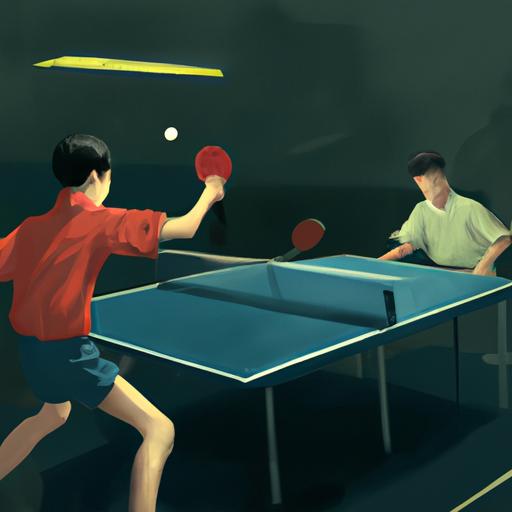Are you an avid table tennis or badminton player? It’s important to choose the right shoe for your game, but what’s the difference between the two? In this article, we’ll take a look at the key features of table tennis and badminton shoes, and how to choose the right one for you.
We’ll look at the thickness of the sole, agility and response, non-marking soles, and the herringbone pattern.
Read on to learn more about these features and how to choose the right shoe for your sport.
Table of Contents
Short Answer
Table tennis shoes and badminton shoes vary in their design and purpose.
Table tennis shoes are usually made of a softer, rubber sole to provide better grip on the court floor and more ankle support.
Badminton shoes are generally designed with a hard, durable sole to provide better stability and durability as well as improved lateral support.
Both shoes are designed to provide good grip and support, but each is tailored to the specific sport.
Overview of Table Tennis Shoes
Table tennis shoes are specifically designed for the sport of table tennis.
These shoes are typically made with a lightweight and flexible design, making them ideal for quick movements around the court.
The sole of a table tennis shoe is usually thicker than that of a badminton shoe, providing extra cushioning and durability.
The non-marking sole of a table tennis shoe is also designed to prevent skidding and slipping while playing.
Other features of a table tennis shoe include a low-profile design with extra arch support for added comfort and stability, as well as a breathable upper to keep your feet cool while playing.
The combination of these features makes table tennis shoes the ideal choice for any table tennis player.
Overview of Badminton Shoes

Badminton shoes are designed to provide players with the agility and quick response times they need to succeed on the court.
They are typically lightweight and flexible, allowing for maximum movement.
The sole of a badminton shoe is usually thin, offering a greater level of flexibility, agility, and responsiveness than a thicker sole.
This allows for quick changes in direction and a low center of gravity, essential for the fast-paced nature of badminton.
The sole of a badminton shoe is usually designed with a herringbone pattern, which helps with grip on the court and reduces the risk of slipping.
This pattern also adds to the durability of the shoe, ensuring it resists wear and tear caused by the hard surfaces of the court.
Badminton shoes often come in a variety of colors and styles to match any outfit, and many feature breathable mesh and foam cushioning to keep your feet comfortable during competitive play.
Thickness of the Sole
When it comes to the difference between table tennis and badminton shoes, one of the main differences lies in the thickness of the sole.
Table tennis shoes typically have a thicker sole than badminton shoes, making them more durable and providing better cushioning.
This thicker sole also makes them great for absorbing shocks from jumps and pivots, which can occur during a game of table tennis.
On the other hand, badminton shoes usually have a thinner sole, allowing for greater agility and a faster response on the court.
This thin sole also helps to provide better balance and control, as players can move around the court more easily and quickly.
In addition to the thickness of the sole, there are also differences in the type of materials used in both types of shoes.
Table tennis shoes are usually made with a synthetic material such as rubber or suede, while badminton shoes are usually made from leather or canvas.
The type of material used will affect the durability and performance of the shoe, so it is important to choose the right material for the type of sport you are playing.
Finally, another difference between table tennis and badminton shoes is the type of sole design.
Table tennis shoes are often designed with a non-marking sole, which allows for better grip and traction on the court.
Badminton shoes, on the other hand, often have a herringbone pattern that helps with grip on the court as well as providing more stability while jumping and pivoting.
In conclusion, there are several important differences between table tennis and badminton shoes.
From the thickness of the sole to the type of material used, it is important to choose the right shoe for the type of sport you are playing to ensure the best performance.
Agility and Response

When it comes to agility and response, table tennis and badminton shoes have some notable differences.
Table tennis shoes typically have thicker soles than badminton shoes to provide better cushioning and durability, which is important for the quick movements and long matches that are common in table tennis.
Badminton shoes, on the other hand, have thinner soles which allow for greater agility and a faster response time on the court.
This is especially important when it comes to badminton, as players need to be able to move quickly to reach shots and react to their opponent’s strategies.
Additionally, table tennis shoes are often designed with a non-marking sole to reduce the risk of slipping, while badminton shoes often feature a herringbone pattern on the outsole to provide additional grip.
While both types of shoes can be used for both sports, it is important to choose the right shoe for the type of sport you are playing to ensure the best performance.
Non-Marking Soles
Table tennis shoes typically have a non-marking sole, meaning they won’t leave marks on a court surface.
This is important for those playing in competitive tournaments, as it prevents any accidental damage to the playing surface.
This is especially important for those playing on wood or synthetic surfaces.
The non-marking sole also helps to protect the integrity of the playing surface, as well as reduce the amount of dirt and debris that can accumulate on the court.
Badminton shoes, on the other hand, often have a herringbone pattern on the sole that helps to provide better grip on the court.
This pattern helps players to move quickly and safely around the court, as well as reduce the risk of slipping or falling.
While both types of shoes can be used for both sports, it is important to choose the right shoe for the type of sport you are playing to ensure the best performance.
Herringbone Pattern

When it comes to the differences between table tennis and badminton shoes, one of the most important is the type of sole they have.
Table tennis shoes typically have a thicker sole, which helps provide more cushioning and durability.
Badminton shoes, on the other hand, usually have a thinner sole.
This helps give the player greater agility and a faster response time when playing.
Another key difference between the two types of shoes is the type of pattern on the sole.
Table tennis shoes typically have a non-marking sole, meaning that they won’t leave behind any marks on the court surface.
Badminton shoes, on the other hand, often have a herringbone pattern.
This pattern helps to provide extra grip on the court, allowing the player to make quick turns and change direction easily.
The type of sole and pattern on the shoe is an important factor to consider when looking for the right pair of shoes for either sport.
While both types of shoes can be used for both sports, it is important to choose the right shoe for the type of sport you are playing to ensure the best performance.
The herringbone pattern on badminton shoes helps to provide extra grip, allowing the player to make quick turns and change direction easily.
With the right shoes, you can take your game to the next level!
Choosing the Right Shoe
When it comes to choosing the right shoes for playing table tennis or badminton, it is important to consider the differences between the two types of shoes.
Table tennis shoes typically have a thicker sole than badminton shoes, making them more durable and providing better cushioning.
This thicker sole also helps protect the feet and ankles from any impact that may occur during the game.
Badminton shoes, on the other hand, usually have a thinner sole, allowing for greater agility and a faster response time on the court.
This thinner sole also provides less cushioning, so it is important to choose a shoe that is comfortable and supportive in order to avoid injury.
In addition, table tennis shoes are often designed with a non-marking sole, while badminton shoes often have a herringbone pattern that helps with grip on the court.
This herringbone pattern provides better traction when playing badminton, allowing players to move quickly and safely around the court.
It also helps to reduce the risk of slipping and falling, which is very important when playing a fast-paced game like badminton.
Overall, it is important to choose the right shoe for the type of sport you are playing to ensure the best performance.
Table tennis and badminton shoes are designed to provide the optimal support and cushioning to help players move quickly and safely around the court.
While both types of shoes can be used for both sports, it is important to consider the differences between them in order to find the right shoe for the job.
With the right shoe, players can enjoy an improved performance and a safer game.
Final Thoughts
Choosing the right shoe for your sport can make a big difference in your performance.
Table tennis shoes are designed with a thicker sole for more cushioning and durability, while badminton shoes usually have a thinner sole for greater agility and a faster response.
In addition, table tennis shoes often have a non-marking sole, while badminton shoes often have a herringbone pattern to help with grip.
With this knowledge in mind, you can now confidently choose the best shoe for the sport you’re playing and get the most out of your performance.

